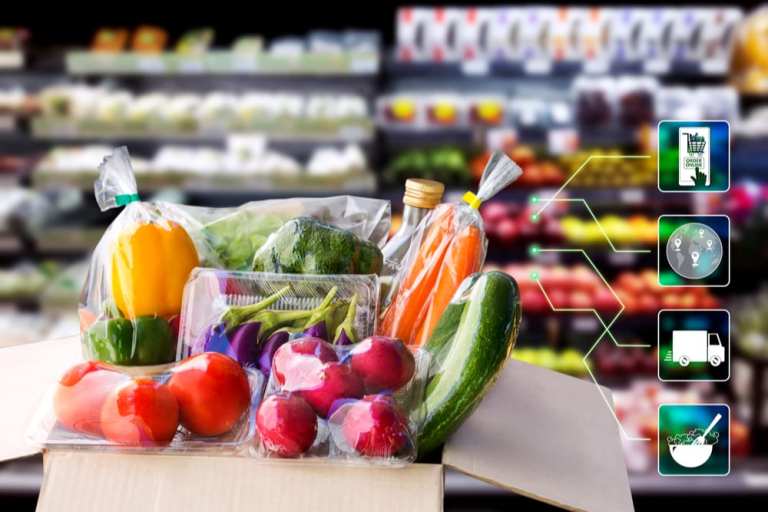
While the world of commerce has been massively disrupted over the last few weeks, the grocery industry has experienced the biggest roller coaster ride in terms of sales swings and rapidly resetting consumer behavior. According to the most recent data PYMNTS has compiled on the subject, an increasing share of consumers are shifting their grocery spending to digital — from 3.9 percent in early March to 14.3 percent in April — but on the whole are shopping for groceries less often than they have historically.
Fiserv Senior Vice Presidet and Head of Grocery Solutions David Conroy told Karen Webster in a recent digital discussion that those figures are consistent with numbers Fiserv has been seeing internally. In the first few weeks of the emerging coronavirus pandemic, increasing numbers of consumers flocked to grocery locations to stock up on toilet paper, hand sanitizer, dry goods, and other essentials — and did so at unprecedented levels, resulting in significant increases in both total grocery transactions and average basket size. The consumer rush also sent a shockwave into some supply chains.
“I don’t think that the industry practitioners necessarily anticipated that spike in demand,” Conroy said, “but they’ve done [a lot] both at the association level and at the retailer and wholesaler level to try and educate consumers and help stabilize the supply chain.”
And now that sanity and stability are beginning to return to a day-to-day life that has rapidly grown more digital, Fiserv and its myriad grocery industry partners are taking a look at building what’s next for a world of commerce that will likely never be the same.
“The opportunities for grocers to gain mindshare and market share are massive,” Conroy noted, “and not just for the very biggest players like Amazon and Walmart, but for small, Main Street grocers as well.”
Building A Digitally-Inclusive Future
The nearly five-fold increase in digital grocery shopping since the outset of the pandemic, Conroy said, has been striking in its speed, but in line with trends that had already been emerging within the industry. Curbside pickup, delivery and other digital and mobile-based grocery interactions were already gaining strength, he said. The COVID-19 crisis pressed the digital accelerator firmly down and is pushing retailers of all sizes to consider new digital offerings for their customer base.
That, he said, has created entirely new challenges — because this hasn’t been like bringing a typical mobile or eCommerce product out to already digitally enabled and enthused consumers, but about creating a digital commerce experience that can meet the needs of anyone and everyone.
“Grocery retailers are quickly and urgently pushing for eCommerce enablement for all customers, not just the digitally inclined. For example, accommodating online ordering for EBT government aid recipients has become a new and pressing need. In addition, cash-centric consumers without credit cards or bank accounts now need the ability to order groceries online and pay in-store or at delivery,” Conroy said. “How do we get those people enabled in a digital environment very, very quickly? That has been a central theme for us and our clients over the past six weeks, and will continue to be into the future.”
One challenge that Fiserv has found it can meet is enabling grocers to accept online EBT payments, a milestone that is allowing many American consumers to shop for groceries online for the first time. The capability is rolling out in conjunction with the USDA SNAP Online Purchasing Pilot, a program for which Fiserv is currently the only supporting merchant acquirer.
It’s been a challenge, he said, but the right one to take on, particularly in conjunction with other areas like unattended retail offerings, mobile checkout offerings or Amazon Go-like setups for retail locations with no employees. These things have all been on the agenda of the Fiserv COVID-19 grocery task force, he noted, which is developing digital responses to address the current crisis, and building future-ready solutions that will digitally-enable grocers when the pandemic is over.
The Emerging New Model
As anyone who has been to a few American grocery stores knows, there is a certain sameness that has pervaded the experience — fresh foods at the periphery, consumer packaged goods in the central aisles and a counter-clockwise flow of traffic are standards of the experience. What has been remarkable over the last six weeks and will be worth watching in the next six months, Conroy said, are the ways in which those old standards are falling away or are being subsumed by new ones.
For example, as restaurants have mostly fallen off the economic map in recent weeks, forward-thinking grocery stores are exploring building meal kits and other prepared food offerings into their core products to fill in a hole in the market. And that mindset across areas, he said, is becoming more pervasive.
“We are working to help grocers link all of these new ideas into loyalty incentives,” he said. “Grocers are thinking that they’ve exposed all of their consumers to these kinds of things over the last six weeks. How do we build on that? How do we keep them coming back? How do we have consumers continue to purchase the increased basket size that they’ve been buying during the pandemic?”
The answers, he said, are still emerging and different players facing different demographics are going about finding them in different ways and with different efforts. But what has been remarkable, he notes, is that significant innovations are happening and at all levels of the grocery game.
Grocery is an industry ripe to change, innovate and become more digitally accessible to all. The necessity of the moment is giving the industry the big push to innovate for which it was long overdue.